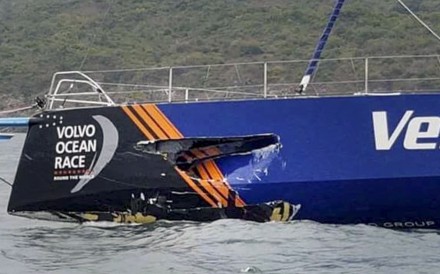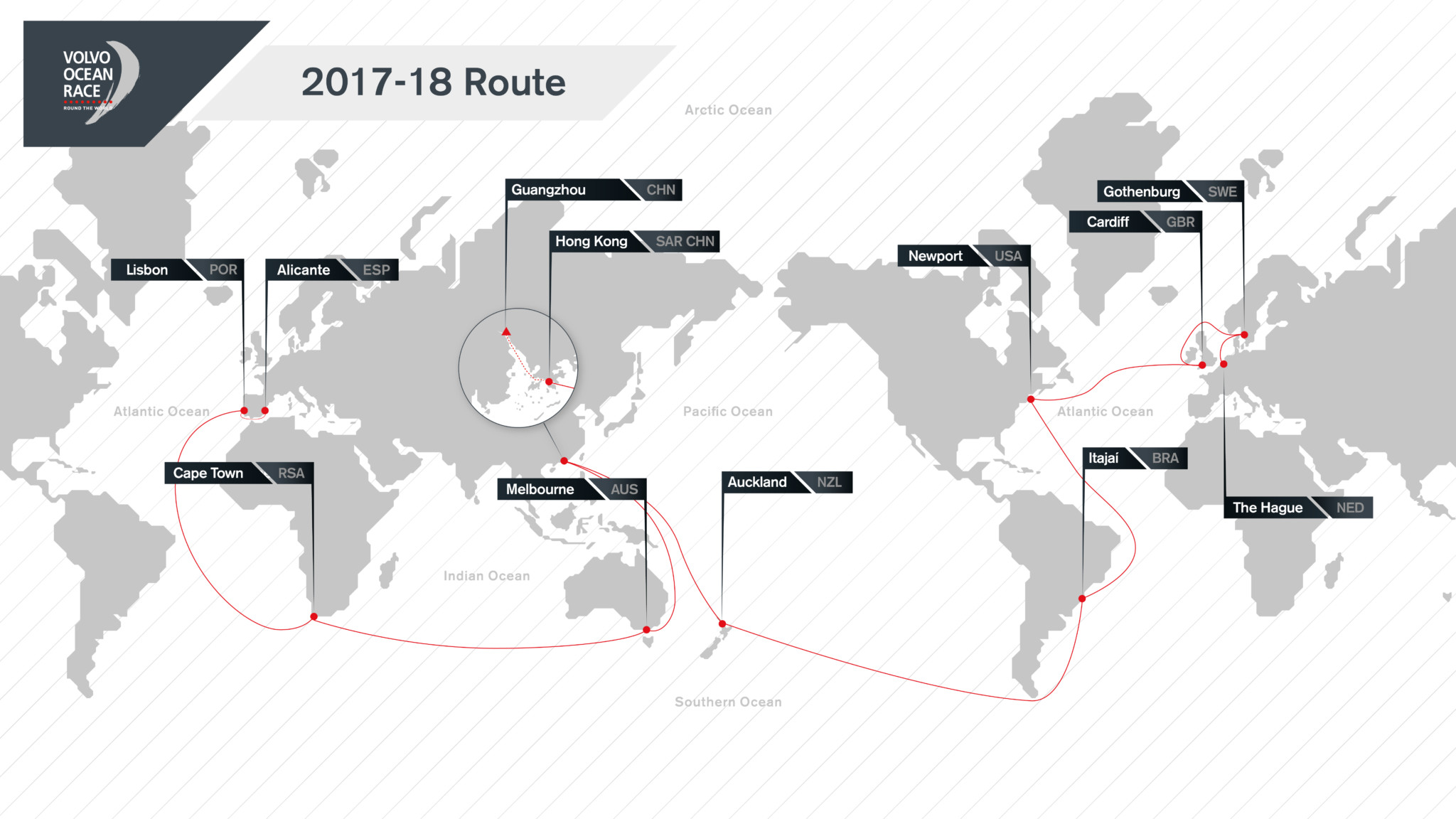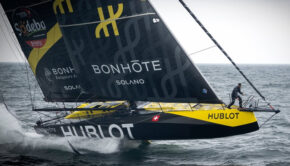Volvo Ocean Race: The blame game
Published on January 20th, 2018
For the first time in the history of the Volvo Ocean Race, a leg would take the fleet to Hong Kong, the former British colony in southeastern China. A 5,600 nautical mile course, beginning January 2, directed the seven teams up the east coast of Australia from Melbourne, into the Coral Sea and up north to the finish.
The course was fraught with obstacles. Many reefs and atolls, some not well mapped, kept navigators busy, but it was the final approach that would lead to disaster. As one of the world’s busiest port cities, the waters also serve a massive fishing community.
The Volvo Ocean Race began having stops in China for the 2008-9 contest, with sailors finding poorly lit fishing fleets in their path. While no collisions had previously occurred, tearing through fishing gear would prove to be a problem.
And now, with the fourth edition of the race to approach this hornet’s nest, Vestas 11th Hour Racing collided with a fishing boat just 30 nm from the finish, sinking the boat and killing one fisherman. Here’s the report from Xinhua News Agency, the official press agency of the People’s Republic of China:
—————-
A local hospital in China’s Hong Kong Special Administrative Region (SAR) confirmed on Saturday (Jan. 20) that a man died after his fishing boat’s collision with a sailing yacht competing in Volvo Ocean Race.
The Chinese mainland-registered fishing boat sunk after colliding with the vessel of American- Danish team Vestas 11th Hour Racing at about 2:30 a.m. local time. Ten fishermen fell into the sea and nine of them were rescued by a mainland rescue vessel with one missing.
The missing fisherman was later saved to the yacht but went unconscious. The Government Flying Service of the Hong Kong SAR sent a helicopter to take the fisherman to Pamela Youde Nethersole Eastern Hospital which declared his death at around 6:30 a.m..
An officer with the Government Flying Service told Xinhua that they received an emergency call at 2:37 a.m. from Hong Kong Maritime Rescue Coordination Center which reported the collision and claimed the missing fisherman.
 The Government Flying Service then dispatched a helicopter to the collision venue, and found that the missing fisherman was saved by the sailing yacht.
The Government Flying Service then dispatched a helicopter to the collision venue, and found that the missing fisherman was saved by the sailing yacht.
Before the collision, the sailing yacht was competing in the fourth leg (Melbourne to Hong Kong) of the around-the-world race and had only 30 nautical miles left to finish.
According to the organizer of the race, all of the crew members of the yacht were safe with limited damage to their boat, and sent SOS radio signal for the fishing boat as well as helped with the rescue after collision.
The organizer expressed their deepest condolences to the family of the victim and promised full cooperation with investigation of Hong Kong authority. Hong Kong police said they are investigating the collision.
—————-
Franck Cammas, who won the 2011-12 edition as skipper and had joined Dongfeng Race Team as navigator, told the AFP news agency how the high number of boats in the water made the final stretch particularly challenging. “We had to slalom a little bit … we were almost at the boat’s maximum speed … with a lot of water in your face… and there’s a lot of noise.”
While it is the commercial component that brings the Volvo Ocean Race to this Asian city, Race Organizers now must deal with the consequences of this decision. With the tracker reporting Vestas was traveling at 20 knots in winds of 23 knots, this team was unable to find a clear path to the finish.
“The death of the fisherman rests squarely on the shoulders of the Race Organizers,” contends Tim Patterson, an avid Scuttlebutt reader. “The sailors are risking their lives to do this race, there is no reason to risk the lives of others.”
Vestas, which was positioned to finish second in the race, retired after the incident. This is the second team the Danish energy company has sponsored in the race, with the previous 2014-15 effort suffering significant damage after colliding with a reef in the Indian Ocean.
To see Leg 4 crew lists… click here.
Race details – Tracker – Scoreboard – Race route – Facebook – YouTube
Leg 4 – Final Results
1. Team Sun Hung Kai/Scallywag (HKG), David Witt (AUS), Finished on Jan 19 at 17:45:42 UTC
2. Dongfeng Race Team (CHN), Charles Caudrelier (FRA), Finished on Jan 19 at 20:33:22 UTC
3. Team AkzoNobel (NED), Simeon Tienpont (NED), Finished on Jan 20 at 00:21:16 UTC
4. MAPFRE (ESP), Xabi Fernández (ESP), Finished on Jan 20 at 01:51:10 UTC
5. Team Brunel (NED), Bouwe Bekking (NED), Finished on Jan 20 at 04:00:56 UTC
6. Turn the Tide on Plastic (POR), Dee Caffari (GBR), Finished on Jan 20 at 04:54:00 UTC
7. Vestas 11th Hour Racing (DEN/USA), Mark Towill (USA), Retired
DTF – Distance to Finish; DTL – Distance to Lead
Overall Results (after 4 of 11 legs)
1. MAPFRE (ESP), Xabi Fernández (ESP), 33 points
2. Dongfeng Race Team (CHN), Charles Caudrelier (FRA), 29
3. Vestas 11th Hour Racing (DEN/USA), Charlie Enright (USA), 23
4. Team Sun Hung Kai/Scallywag (HKG), David Witt (AUS), 19
5. Team Brunel (NED), Bouwe Bekking (NED), 17
6. Team AkzoNobel (NED), Simeon Tienpont (NED), 14
7. Turn the Tide on Plastic (POR), Dee Caffari (GBR), 8
2017-18 Edition: Entered Teams – Skippers
• Team AkzoNobel (NED), Simeon Tienpont (NED)
• Dongfeng Race Team (CHN), Charles Caudrelier (FRA)
• MAPFRE (ESP), Xabi Fernández (ESP)
• Vestas 11th Hour Racing (DEN/USA), Charlie Enright (USA)
• Team Sun Hung Kai/Scallywag (HKG), David Witt (AUS)
• Turn the Tide on Plastic (POR), Dee Caffari (GBR)
• Team Brunel (NED), Bouwe Bekking (NED)
Background: Racing the one design Volvo Ocean 65, the 2017-18 Volvo Ocean Race begins in Alicante, Spain on October 22 2017 with the final finish in The Hague, Netherlands on June 30 2018. In total, the 11-leg race will visit 12 cities in six continents: Alicante, Lisbon, Cape Town, Melbourne, Hong Kong, Guangzhou, Auckland, Itajaí, Newport, Cardiff, Gothenburg, and The Hague. A maximum of eight teams will compete.












 We’ll keep your information safe.
We’ll keep your information safe.